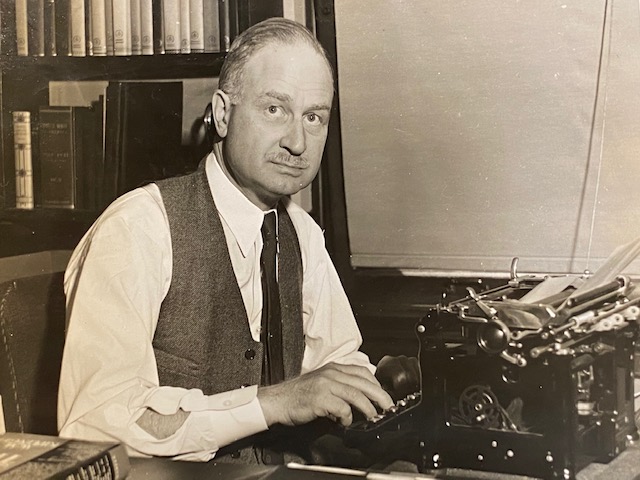Kiplinger Newsletters Are Geared to the Digital Age
New book shows how Willard Kiplinger created newsletter journalism in the 1920s still valuable to readers in the digital age.

A message from editor emeritus Knight Kiplinger:
Each week my colleagues and I send four pages of concise forecasts about business, the economy and government policies to people in management all over America.
Those four pages are called The Kiplinger Letter, and our subscribers use it to figure out what lies ahead, for the benefit of their organizations and themselves.

Sign up for Kiplinger’s Free E-Newsletters
Profit and prosper with the best of expert advice on investing, taxes, retirement, personal finance and more - straight to your e-mail.
Profit and prosper with the best of expert advice - straight to your e-mail.
What many of our readers may not know is that our savvy, Washington-based reporters and editors are fulfilling the same mission, in much the same way, as their predecessors at Kiplinger did, going back 99 years.
Next year will be the 100th anniversary of the first issue, in September of 1923. (I would be born 25 years later and would become, by the 1980s, the third generation of Kiplingers to edit the Letter.)
The reasons for the Letter’s longevity are rooted in editorial innovations that were modern and compelling in 1923, and even more so today:
- Not just dry news (what government officials say and do), but bold forecasts based on thorough reporting and analysis, relying on unnamed but highly trustworthy sources
- Lean, colloquial writing, to save the reader’s valuable time
- Political and ideological independence
- Strong engagement with our readers, who are encouraged to contact us for more information and to suggest story ideas
The mastermind behind the Letter, my grandfather W.M. Kiplinger (1891-1967), has been called the Father of the Modern Newsletter, a man who foreshadowed trends that would intensify with the rise of digital journalism decades after his career ended.
Rob Wells, a veteran business reporter and professor of journalism at the University of Maryland, writes in a recent Washington Post article, “There are many echoes of Kiplinger’s vision in our modern media. His emphasis on concise writing is foundational to modern digital newsletters, and it will continue to be important as the media landscape and online content only continue to grow.”
The Kiplinger Letter rose to prominence in the tumultuous early days of the New Deal in 1933, with the world mired in depression, the future of free enterprise hanging in the balance, and many Americans clamoring for government regulation of previously unfettered capitalism.
Kiplinger’s subscribers mostly opposed this regulation and wished the economy could just recover on its own. They were alarmed by his forecasts of radical new policies coming out of the Roosevelt administration, where he had highly placed sources.
But like it or not, he told his readers, this new order of government intervention is here to stay, and rather than rail against it, they would be wise to get involved in shaping the policies.
“Kiplinger called on businesses to engage in the political process and become decent corporate citizens,” Wells writes. “He saw himself as part of a movement to make businesses more accountable, a movement that helped reshape capitalism. That meant making compromises, such as working with organized labor for the common good” — a sentiment that was anathema to many business leaders in the 1930s, including many of his own Kiplinger Letter readers.
“Kiplinger was the rare journalist,” Wells writes, “who understood both Wall Street and Washington” — and, I might add, Main Street, the world of small businesses all over America, struggling with the new regulations just as Big Business was.
Kiplinger’s creative mind and concern for the wellbeing of everyday people also led to his starting, in 1947, the first magazine about personal money management, today’s monthly Kiplinger’s Personal Finance.
W.M. Kiplinger’s life and work have never been studied in depth by historians of journalism — until now, in a new scholarly book by Professor Wells. It’s called The Insider: How the Kiplinger Newsletter Bridged Washington and Wall Street. (Use the promo code MASINSIDER to get a $23 paperback price, a 30% discount for Kiplinger readers.)
The book focuses on Kiplinger’s work in the 1930s, a chaotic, contentious time in America. The public acrimony of that era would resurface from time to time in subsequent decades, including the late 1960s and 1970s (when I was starting in newspaper journalism, before joining the Kiplinger staff), and in today’s bitterly polarized world.
Through all those years, The Kiplinger Letter has hewn to our original mission, with calm, dispassionate, nonpartisan analysis and forecasts. It’s designed to be useful to our readers, and it’s a legacy worth continuing.
Get Kiplinger Today newsletter — free
Profit and prosper with the best of Kiplinger's advice on investing, taxes, retirement, personal finance and much more. Delivered daily. Enter your email in the box and click Sign Me Up.
-
 Stock Market Today: Dow Drops 971 Points as Powell Pressure Ramps Up
Stock Market Today: Dow Drops 971 Points as Powell Pressure Ramps UpPresident Trump is increasing his attacks against Jerome Powell, insisting the Fed chair cut interest rates.
By Karee Venema
-
 Get Netflix, Hulu and Apple TV Plus for Free by Joining T-Mobile
Get Netflix, Hulu and Apple TV Plus for Free by Joining T-MobileT-Mobile customers save up to $35/month on streaming services thanks to this Netflix, Hulu and Apple TV Plus bundle. Here’s how to get it.
By Rachael Green